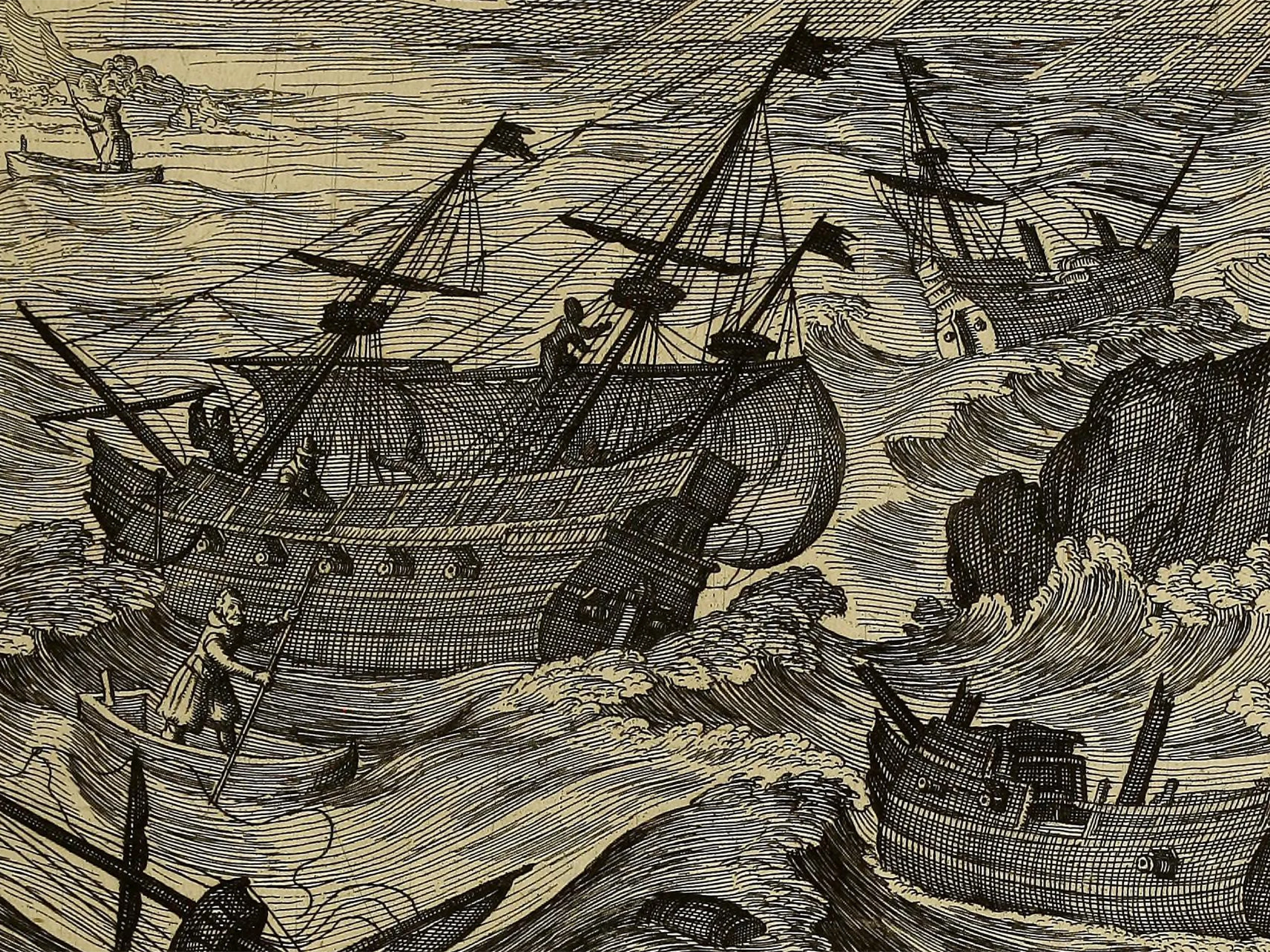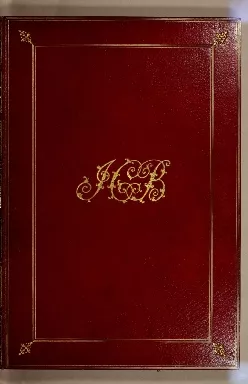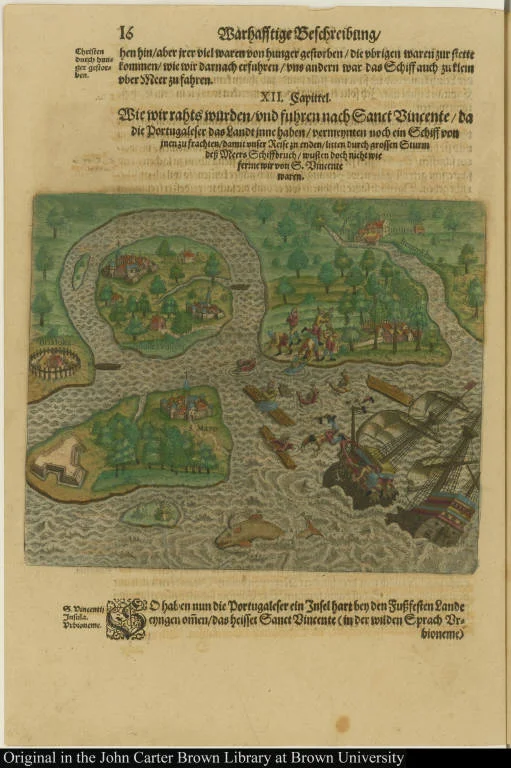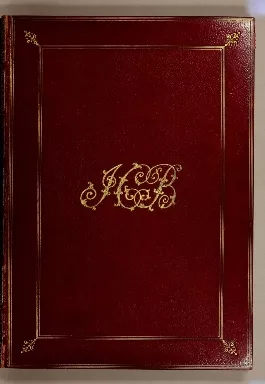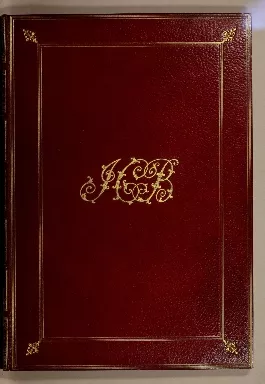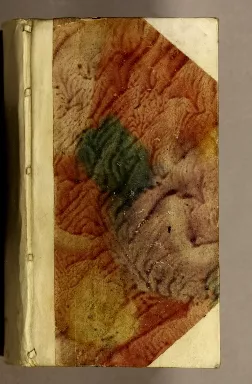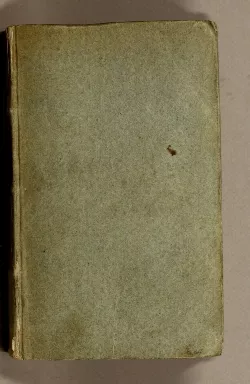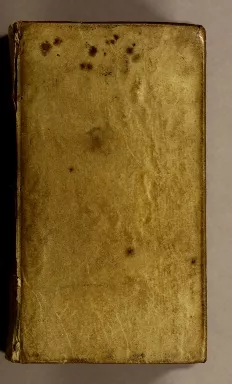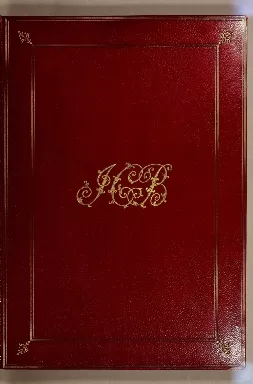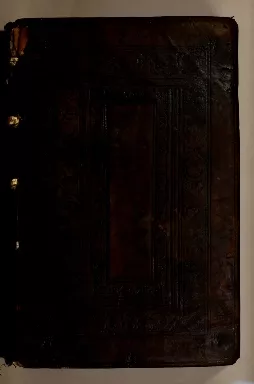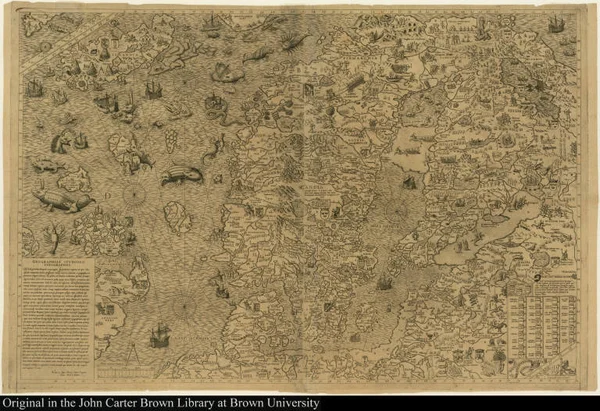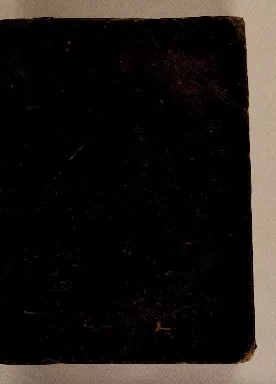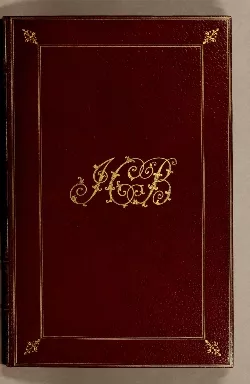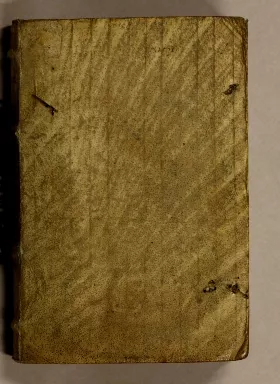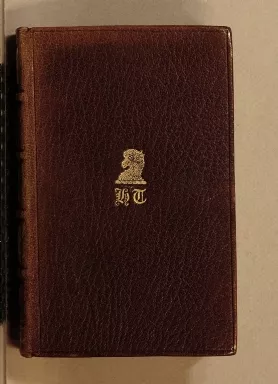1. Shipwrecks
Das vierdte Buch von der Neuwen Welt
1613
-
 p. 211
p. 211During Columbus's second voyage to the New World in 1493, while at the island of Hispaniola, a strong hurricane devastated the coastal regions and destroyed all but three ships of the Spanish fleet, with the loss of many lives. Even the three surviving ships were heavily damaged and had to be urgently repaired before Columbus could return to Spain.
[How we attempted to sail to Saint Vincent in the possession of the Port...
1492-1600
-
 p. 1
p. 1On his second voyage to South America, from Spain to Brazil (1549-1554), Hans Staden suffered a shipwreck near São Vicente Island (in the neighborhood of present-day São Paulo). He was later captured by the Tupi Indians and, after many ordeals and often being close to death, was finally rescued by the captain of a French ship which had come to Brazil to trade with the Indians.
A briefe and true report of the new found land of Virginia
1590
-
 p. 55
p. 55This famous engraving by de Bry, headed "The Arrival of the Englishmen in Virginia," is based on a drawing (now lost) by John White, who participated in five voyages to North America. It shows several narrow islands of the Carolina Outer Banks and, in the left center, Roanoke Island, the site of the first two British settlements in the New World (1585-1586; 1587-1588?).
While the text describes the arrival of the first English expedition, sent out by Sir Walter Raleigh in 1584, the drawing was not made then; rather, it represents the situation in the middle of June 1586, after a devastating hurricane on 13 June. This storm caused the destruction of many of the smaller ships of the fleet assembled under the command of Sir Francis Drake, which had stopped at the Carolina Outer Banks after voyaging to the West Indies to visit with and take some supplies to the first English colony.
It was the loss of these supplies in the shipwrecks (five stranded ships are depicted) that convinced Ralph Lane, governor of the colonists, to abandon the settlement. He and his men hastily left North America and returned to England on several of Drake's ships.
Zehender Theil America
1618
-
 p. 107
p. 107The engraving shows the wreckage of three French ships during a storm near the French coast at La Rochelle in November 1615 and the escape of Captain John Smith (1580-1631) in a small open boat (top left) to an island at the mouth of the Charente River. Nearly drowned and close to death from fear, cold, and hunger, Smith was rescued by fowlers. He had been on his way to New England (his second voyage to this region) when he was taken prisoner by French privateers and pirates near the Azores.
Geschichte des Herrn C. Le Beau, Advocat im Parlament. Oder Merckwürdig...
1752
-
 p. 61
p. 61The French Royal ship L'Elephant, on its way from La Rochelle, France, to Quebec, found itself entangled in a heavy storm in the St. Lawrence River at about midnight on 15 June 1729. The ship was pushed against some rocks and had to be abandoned after it capsized.
The engraving shows the survivors, who lost all their belongings and had to walk all the way to Quebec City, a distance of about 55 miles, without any roads available. The ship on the left is a French privateer that refused to come to the help of her shipwrecked countrymen out of fear for her own safety.
Journael van de ongeluckighe voyagie, gedaen by den Commandeur Dirck Alb...
1663
-
 p. 1
p. 1The Dutch merchant ship Spitsbergen was heavily damaged on 22 May 1639 in a storm east of Greenland. The vessel lay helplessly on its side, tossed around by the waves. After an ordeal of two days without food and water and suffering from extreme cold, 20 survivors (of a crew of 84) were rescued by the Dutch ship Oranjeboom.
Barnabas Downs
1972
-
 p. 1
p. 1A facsimile of the 1786 edition, printed from the copy in the John Carter Brown Library (no. 7 above) by the Meriden Gravure Company, with an introduction by Samuel J. Hough.
An account of the Pelew Islands, situated in the western part of the Pac...
1788
-
 p. 1
p. 1During the night of August 9 to 10, 1783, the British mail ship Antelope, under the command of Captain Henry Wilson and with a crew of 50, was shipwrecked on a coral reef in heavy seas and a terrible rainstorm. Without loss of life, the crew was able to get off the reef in their lifeboats.
Subsequently, contact with the indigenous population on the islands beyond the reef was established, and the British sailors, the first Europeans to arrive here, were well received. During the next three months, through mutual respect and trust, the members of the two vastly different cultures generally arranged to live in harmony and friendship. After building a new vessel with tools and supplies from their stranded ship, the Englishmen left the Palau Islands on November 12, 1783, and returned to Macao, the Portuguese port south of Canton, China, where they had started their voyage in July of the same year.
On the map, Canton, China, is shown in the top left corner, and the Palau Islands are found in the lower center (east of the Philippines and west of the Carolines). The plate depicts the arrival of a group of Englishmen in their boat at the island of Pelelew, accompanied by an outrigger boat manned by native Palau islanders.
Des See-Capitains Franz Urban Bawiers Merckwürdige Reisen und Begebenhe...
1752
-
 p. 52
p. 52The poem is divided into three cantos, and the scene is set in the eastern Mediterranean (the Aegean Sea), between the island of Crete ("Candia") and the island of Ayios Yeorgios ("St. George") off the southern tip of Attica in Greece. The left-hand page (p. [40]) shows the contents of the second canto of the poem. Other pages [not shown] often have footnotes explaining nautical terms.
2. Sea-Monsters
Francesci Redi, nobilis Aretini, Experimenta circa res diversas naturale...
1675
-
 p. 107
p. 107"'Pece Muger,' or 'Pesci Donne,' reportedly having been seen off the coast of Brasil, has tender bones, which [when used in the proper manner] promote chastity, inhibit carnal desires, render men impotent, and are useful in many other ways for the good of the body."
("Haec ossa multum prosunt castitati, & ad reprimendos motus carnales: quin homines reddunt impotentes, & multis aliis in rebus inserviunt ad salutem corporis.")
Americae pars quarta. Sive, Insignis & admiranda historia de reperta pri...
1594
-
 p. 179
p. 179Theodor de Bry's engraving portrays Columbus gazing at seductive sirens, one of whom carries a quiver full of arrows and almost appears to be part Amazon, part mermaid.
Den verstandigen hovenier
1677
-
 p. 1
p. 1This Dutch author talks about the "wonders of the sea." According to him, merpeople are capable of living on land, learning how to break bread with humans, yet they forever remain without speech. The illustration shows a "knight of the ocean" and his noble wife with her comb and mirror.
Histoire de l'isle Espagnole ou de S. Domingue
1733
-
 p. 1
p. 1Mermonsters are considered to have decorative and symbolic qualities, and representations are found in certain heraldic designs. In this case, a two-tailed sea-woman and sea-man are used as the border of the title vignette.
Chronica regnorum aquilonarium Daniae Suetiae Noruagiae
1546-1548
-
 p. 15
p. 15This ornamental trio in the initial seems to be serenading the Gentle Reader.
[Carta marina et descriptio septentrionalium Terrarum]
1572
-
 p. 1
p. 1This map shows an abundance of aquatic monsters.
The sea serpent is often reported to have been seen but is not identifiable with any known animal and is probably based on pure fiction. The sea unicorn has one or two long twisted tusks projecting like a horn. Its color has been likened to that of a human corpse.
A compendious history of the Goths, Svvedes, & Vandals, and other northe...
1658
-
 p. 1
p. 1On display is chapter one on "Monstrous Fishes." This horror story of the wailing creatures from the Deep has been repeated through many editions and translations.
Historia delle genti et della natura delle cose settentrionali
1565
-
 p. 1
p. 1The sea cow is based on a large aquatic mammal with rudimentary hind limbs. The mythical sea horse is a fabulous creature, half horse and half fish.
Historia de gentibus septentrionalibus, earumque diuersis statibus, cond...
1555
-
 p. 1
p. 1The sea hog more than likely represents an unattractive version of the porpoise or the dolphin.
Wonderen soo aen als in, en wonder-gevallen soo op als ontrent de zeeën...
1687
-
 p. 1
p. 1Much imagination was used by the artist who created this frontispiece. Especially impressive is what looks like a "griffin of the sea."
3. Sailors
The English pilot
1745
-
 p. 1
p. 1Captain James Brown (1724-1751) was the eldest son of James and Hope (Power) Brown of Providence and the granduncle of John Carter Brown (1797-1874). He was the master of the sloop Chaniel and died unmarried at York, Virginia.
This pilot was bought by Captain Brown in Boston in 1748. It is the earliest recorded acquisition of a book by a member of the Brown family, which is currently part of the Library's collection.
The mariner's new calendar
1761
-
 p. 43
p. 43This work was first published in London in 1675; it was a standard navigation manual for over a century. The copy shown contains calculations as well as various manuscript notes and ink drawings.
Atlas manuale: or, A new sett of maps of all parts of the earth, as well...
1723
-
 p. 1
p. 1Displayed is a manuscript annotation concerning ambergris, "supposed to be ye excrements of a whale," which is still used in perfumery as a fixative. This atlas contains the bookplate of "The Right Hon.ble Henry Bowes Howard Earl of Suffolk & Berkshire. 1750."
The English pilot
1749
-
 p. 1
p. 1On the back endpapers of this copy, John Woodsum wrote in 1787:
"When this you see
remember me
and keep me Still in mind
and I am not like a weather cock
that Changes with the wind--
God made man and man made money
god made bees and bees made honey.
god made satan
and satan made sin.
The Lord have mercy on our Souls."
The English pilot
1789
-
 p. 1
p. 1This English pilot has copious manuscript notes throughout, including directions and instructions, love poems, and accounts. The poem displayed was noticed by Admiral Steve Ritchie from Scotland, a research fellow at the Library in 1986.
The American coast pilot, containing the courses & distances between the...
1815
-
 p. 1
p. 1These drawings of the female form (with the emphasis on the décolletage) would appear to reflect sailors' dreams and desires.
The American coast pilot: containing directions for the principal harrou...
1833
-
 p. 1
p. 1The endpaper in this copy shows pencil drawings of jibs.
4. Syphilis and Scurvy
Achter Theil der Orientalischen Indien
1606
-
 p. 7
p. 7Includes Roelof Roelofsz's Historische Beschreibung der Schiffart, so der Admiral Jacob von Neck ... gethan, 1st publ., Frankfurt a. M., 1605, in Zwo underschiedliche newe Schiffahrten. On page two, an account is presented in which hapless sailors attempt to cure scurvy through ingestion of tobacco. From the original collection of John Carter Brown.
An essay on the most effectual means of preserving the health of seamen ...
1774
-
 p. 1
p. 1The problem of scurvy attracted serious consideration by medical men in the eighteenth century. In this work, first published in London in 1757, Lind identified the cause of scurvy and means for its avoidance.
Report of the committee appointed by the Lords Commissioners of the Admi...
1877
-
 p. 1
p. 1As evidenced by this work on Arctic exploration, scurvy remained a problem long after its causes had been identified, as logistical problems prevented explorers from obtaining proper food supplies.
A deposition concerning lime juice is presented on page 78.
European Americana
1980-1997
-
 p. 1
p. 1The first volume of the John Carter Brown Library's landmark reference work is opened to the beginning of the index entries for syphilis. The literature of the fifteenth century is rife with material on the disease that was associated with the return to Europe of Columbus and his men.
Libellus de epidemia, quam uulgo morbum gallicum uocant
1497
-
 p. 1
p. 1One of the first books to discuss syphilis; the earliest such book held by the Library. From the printing house of Aldus Manutius, as indicated in the colophon.
Senatus populique Genuensis rerum domi forisque gestarum historiæ atque annales
1579
-
 p. 1
p. 1On pages 371-376 is a substantial account of Columbus and Spanish exploration; p. 383 contains references to the possible New World source of syphilis. From the printing house of Christophe Plantin.
4.1. Curing Syphilis
Hieronymi Fracastorii Syphilis sive Morbus Gallicus
1530
-
 p. 1
p. 1Just as syphilis was widely accepted as indigenous to the New World, many believed that its cure, too, by divine providence, would be found in America. Guaiacum, a resin obtained from two species of tropical American trees, was among the earliest and most widely promoted remedies.
Capitulo ouer recetta delo arbore ouer legno detto Guaiana: remedio cont...
1520
-
 p. 1
p. 1On the use of guaiacum for treating syphilis. The extent of the literature on treatment with guaiacum and the length of time the cure remained in vogue suggest the likelihood of a strong placebo effect.
Caption title with illustration.
Liber de morbo Gallico, in quo diuersi celeberrimi in tali materia scrib...
1535
-
 p. 5
p. 5Contains N. Leoniceno, De epidemia quam Italicum morbum Gallicum ... vacant (1st publ., Venice, 1497); U. von Hutten, De admiranda guaiaci medicina (1st publ., Mainz, 1519); P. A. Mattioli, Morbi Gallici novum ... opusculum (1st publ., Bologna, 1533); L. Fries, Epitome opusculi de curandis pustulis (1st publ., Basel, 1532); Scribonius Largus: excerpts from De compositione medicamentorum liber (Basel, 1529); J. Almenar, Libellus de morbo Gallico (1st publ., Venice, 1502); A. Bolognini, Liber de cura ulcerum exteriorum (1st publ., Bologna, 1514). Normally bound with this is Nicolaus Pol's De cura morbi Gallici of this year, which is bibliographically distinct.
This compendium of works on syphilis, "the French disease", includes Ulrich von Hutten's book promoting guaiacum on behalf of a family that had been granted a monopoly on its distribution in Europe.
Secretos de chirurgia
1567
-
 p. 211
p. 211Among several chapters on syphilis, folios 103-105 discuss the treatment of the disease through sarsaparilla, also native to America.
Items Pending Integration
Project Creator(s)
- The John Carter Brown Library
